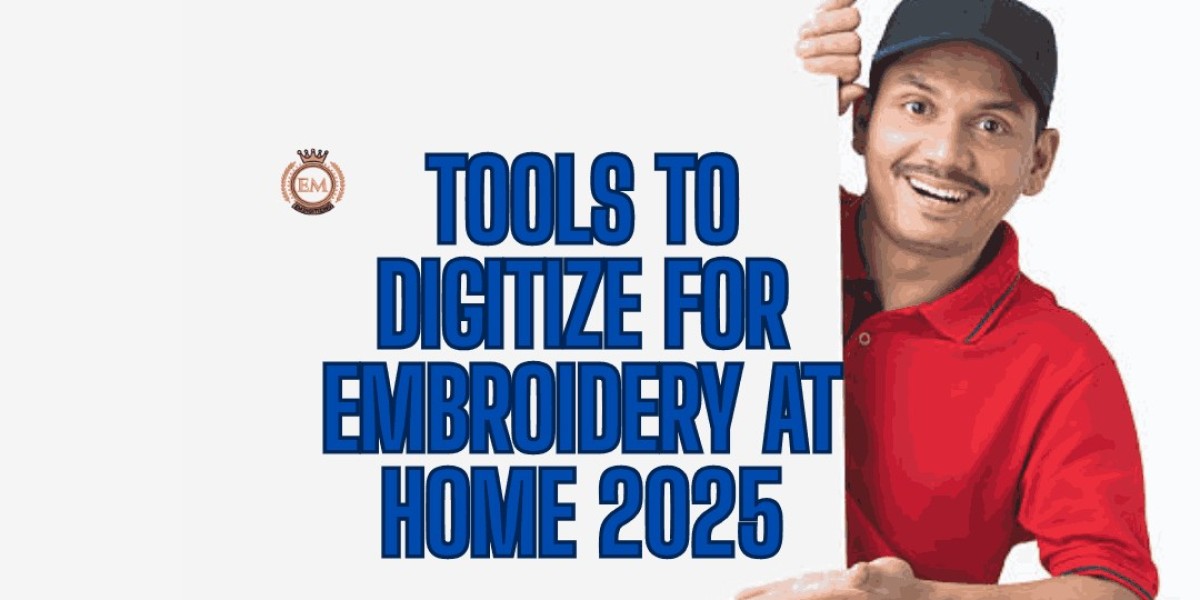Digitizing for embroidery transforms artwork into digital stitch files that embroidery machines use to create designs on fabric, enabling anyone to craft professional-quality embroidery from the comfort of home. With the right tools, hobbyists and small business owners can produce personalized designs for apparel, gifts, or décor without relying on professional services. This blog outlines the essential tools you need to digitize for embroidery at home, providing a comprehensive guide for setting up your digitizing workspace in 2025.
From software to hardware, these tools make the embroidery digitizing process accessible and efficient. By adopting the best embroidery digitizing practices, you can create high-quality designs that rival professional work. Let’s explore the must-have tools for home digitizing success.
What Does Digitizing for Embroidery Involve?
Digitizing for embroidery involves converting images, logos, or designs into digital files that guide embroidery machines on stitch types, colors, and patterns. At home, this process requires a combination of software for creating stitch files, hardware for stitching, and accessories to ensure precision and quality.
Understanding the tools involved empowers you to streamline the digitizing process, producing designs that meet your creative vision. Whether you’re a beginner or an experienced embroiderer, the right tools make home digitizing rewarding and achievable.
Tool 1: Embroidery Digitizing Software
Digitizing software is the cornerstone of creating stitch files at home. These platforms allow you to convert artwork into embroidery designs, offering features like stitch type selection, density control, and color mapping. For home use, choose user-friendly software with beginner-friendly interfaces or free versions to keep costs low.
Look for software that supports common file formats like DST or PES and includes tutorials for learning. Affordable options with auto-digitizing features can simplify the process, while advanced tools offer manual editing for intricate designs, catering to all skill levels.
Choosing Digitizing Software
When selecting software, consider these features:
Stitch Editing Tools: Adjust satin, fill, or running stitches for variety.
File Compatibility: Ensure support for your machine’s format.
Auto-Digitizing: Convert simple images quickly for beginners.
Tutorials and Support: Access guides for learning the software.
These features make software a vital tool for home digitizing.
Tool 2: Graphic Editing Software
Before digitizing, you’ll need graphic editing software to prepare your artwork. High-quality designs require clean, simplified images, preferably in vector formats (.SVG, .AI) or high-resolution bitmaps (300 DPI). Graphic editors help refine logos, text, or patterns, ensuring they’re suitable for stitching.
Free or affordable graphic editors with basic functions like cropping, color adjustment, and outline creation are ideal for home use. These tools complement digitizing software, ensuring your artwork translates into clear, professional embroidery designs.
Graphic Editing Software Tips
To choose a graphic editor, focus on these:
Vector Support: Edit .SVG files for scalable designs.
Layer Management: Organize elements for complex designs.
Color Tools: Match colors to thread shades.
Export Options: Save in formats compatible with digitizing software.
A good graphic editor enhances your digitizing workflow at home.
Tool 3: Embroidery Machine
An embroidery machine is essential for stitching your digitized designs. Home machines range from single-needle models for beginners to multi-needle options for advanced users. Choose a machine with USB or Wi-Fi connectivity to transfer stitch files easily and a variety of hoop sizes for different projects.
Ensure the machine supports common file formats and includes built-in editing features for minor adjustments. A reliable embroidery machine brings your digitized designs to life, making it a core tool for home embroidery.
Selecting an Embroidery Machine
When choosing a machine, consider these factors:
File Compatibility: Supports formats like PES, DST, or EXP.
Hoop Sizes: Offers multiple sizes for versatility.
Connectivity: USB or Wi-Fi for easy file transfers.
Built-In Stitches: Includes fonts or patterns for quick projects.
These features ensure your machine meets home digitizing needs.
Tool 4: Computer or Tablet
A computer or tablet is necessary to run digitizing and graphic editing software. For home digitizing, a mid-range device with at least 8GB RAM, a decent processor, and sufficient storage (500GB or more) handles most tasks efficiently. Tablets with stylus support can be useful for sketching designs directly.
Ensure the device has USB ports or Wi-Fi for transferring files to your embroidery machine. A reliable computer or tablet serves as the hub for your digitizing workflow, making it indispensable for home setups.
Device Requirements
To choose a device, check these specifications:
Operating System: Compatible with your software (Windows, macOS, or iOS).
Processing Power: Handles software without lagging.
Storage Space: Stores designs and stitch files securely.
Connectivity Options: Supports USB or Wi-Fi for file transfers.
A capable device streamlines your home digitizing process.
Tool 5: Embroidery Threads and Needles
Quality threads and needles are critical for bringing digitized designs to life. Polyester or rayon threads are popular for home embroidery due to their durability and vibrant colors. Choose thread weights (e.g., 40-weight) suitable for your designs and fabrics.
Needles should match your fabric type—universal needles for standard fabrics, ballpoint for knits, or sharp for wovens. Having a variety of threads and needles ensures your designs stitch smoothly and look professional on any project.
Thread and Needle Selection Tips
To choose threads and needles, consider these:
Thread Type: Polyester for durability, rayon for shine.
Needle Size: Use sizes 75/11 or 90/14 based on fabric.
Color Variety: Stock multiple shades for design flexibility.
Quality Brands: Opt for reliable threads to avoid breaks.
These supplies enhance the quality of your home embroidery.
Tool 6: Stabilizers and Backings
Stabilizers, or backings, support fabrics during embroidery, preventing puckering or stretching. For home digitizing, stock cut-away stabilizers for stable fabrics like cotton, tear-away for delicate materials, and wash-away for freestanding designs. The right stabilizer ensures clean stitches, especially for complex digitized designs.
Choose stabilizers based on your fabric and design density. Testing stabilizers with your digitized files helps identify the best match, ensuring professional results on home projects.
Stabilizer Selection Guidelines
When choosing stabilizers, focus on these:
Cut-Away: Ideal for stretchy or heavy fabrics.
Tear-Away: Suitable for light, non-stretch materials.
Wash-Away: Perfect for lace or temporary support.
Weight Options: Match stabilizer weight to fabric thickness.
Stabilizers are essential for flawless home embroidery.
Tool 7: Hoops and Frames
Embroidery hoops or frames secure fabric during stitching, ensuring even tension for accurate designs. Home embroidery machines come with standard hoops, but additional sizes (e.g., 4x4 or 5x7 inches) offer flexibility for various project scales. Magnetic or adhesive hoops can simplify fabric placement.
Ensure hoops are compatible with your machine and suitable for your fabric type. Proper hooping, guided by your digitized design’s size, prevents misalignment and ensures professional-quality embroidery at home.
Hoop Selection Tips
To choose hoops, consider these:
Size Variety: Match hoop size to design dimensions.
Machine Compatibility: Ensure hoops fit your embroidery machine.
Magnetic Options: Simplify placement for thick fabrics.
Tension Control: Check for adjustable hoops to avoid stretching.
Hoops are critical for precise home digitizing results.
Tool 8: Measuring and Marking Tools
Measuring and marking tools, like rulers, fabric markers, and placement guides, help position designs accurately on fabric. These tools ensure your digitized design aligns perfectly, especially for projects like monogrammed gifts or apparel. Water-soluble or air-erasable markers are ideal for temporary markings.
Accurate measurements prevent costly errors, ensuring your embroidery matches your vision. These simple tools are indispensable for maintaining precision in home digitizing projects.
Using Measuring and Marking Tools
To leverage these tools, follow these tips:
Use Clear Rulers: Measure design placement precisely.
Choose Safe Markers: Opt for water-soluble or erasable pens.
Alignment Guides: Use templates for consistent placement.
Double-Check: Verify measurements before stitching.
These tools enhance accuracy in home embroidery setups.
Optional Tools for Enhanced Digitizing
While not essential, these tools can elevate your home digitizing experience:
Lightbox or Tracing Pad: Helps trace designs for manual digitizing.
Thread Organizer: Keeps threads sorted for quick access.
Design Scanner: Digitizes hand-drawn sketches for software use.
External Storage: Backs up stitch files securely.
These extras streamline workflows and add convenience for home embroiderers.
Challenges and Solutions in Home Digitizing
Home digitizing may present challenges, but solutions make it manageable:
Challenge: Software Learning Curve
Solution: Use tutorials and start with simple designs.Challenge: Fabric Puckering
Solution: Test stabilizers and adjust stitch density.Challenge: File Compatibility
Solution: Verify formats match your machine’s requirements.Challenge: Limited Budget
Solution: Opt for free or affordable tools initially.
Addressing these ensures a smooth home digitizing experience.
Tips for Successful Home Digitizing
To excel in digitizing at home, follow these tips:
Start with Simple Designs: Practice with text or basic shapes.
Test Designs First: Stitch samples on scrap fabric to check quality.
Organize Files: Label and back up stitch files for easy access.
Learn Fabric Types: Adjust settings for cotton, knits, or denim.
Join Communities: Connect with embroiderers for tips and support.
These strategies enhance your home digitizing skills and results.
The Role of Technology in Home Digitizing
Modern technology simplifies home digitizing with user-friendly tools:
Auto-Digitizing Features: Convert images quickly for beginners.
Cloud Integration: Share and store designs across devices.
Mobile Apps: Offer on-the-go design editing for convenience.
Virtual Previews: Visualize stitches before production.
These advancements, part of the best embroidery digitizing practices, make home digitizing accessible in 2025.
Conclusion
To digitize for embroidery at home, you need a combination of digitizing software, graphic editors, an embroidery machine, a computer or tablet, threads, needles, stabilizers, hoops, and marking tools. These tools, paired with optional extras like lightboxes, empower you to create professional-quality designs for personal or small business projects in 2025. By mastering the embroidery digitizing process and adopting the best embroidery digitizing practices, you can transform your home into a creative embroidery hub. Start gathering these tools today to bring your designs to life with precision and flair.
FAQs
Q: What does it mean to digitize for embroidery at home?
Digitizing for embroidery at home involves converting artwork into digital stitch files using software and tools to create designs for embroidery machines.
Q: Do I need expensive software to digitize at home?
No, free or affordable software with basic features is sufficient for beginners, with tutorials to guide you through the process.
Q: Why are stabilizers important for home embroidery?
Stabilizers prevent fabric puckering or stretching, ensuring clean, professional stitches for your digitized designs.
Q: Can I digitize on a tablet instead of a computer?
Yes, tablets with compatible software and stylus support can be used for digitizing, especially for sketching or editing designs.
Q: How do I choose threads for home embroidery?
Select polyester or rayon threads in various colors, matching 40-weight threads to your fabric and design for durability and vibrancy.








